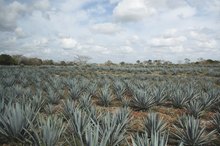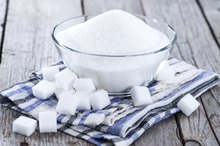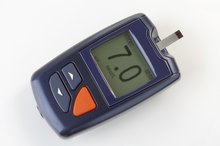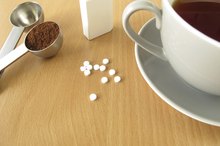What does fact checked mean?
At Healthfully, we strive to deliver objective content that is accurate and up-to-date. Our team periodically reviews articles in order to ensure content quality. The sources cited below consist of evidence from peer-reviewed journals, prominent medical organizations, academic associations, and government data.
- "Journal of the Formosan Medical Association; Effects of high-fructose (90%) corn syrup on plasma glucose, insulin, and C-peptide in non-insulin-dependent Diabetes Mellitus and Normal Subjects; C. Hung; September 1989
- "Journal of the Formosan Medical Association; Effects of high-fructose (90%) corn syrup on plasma glucose, insulin, and C-peptide in non-insulin-dependent Diabetes Mellitus and Normal Subjects; C. Hung; September 1989
- MayoClinic.com; High-Fructose corn Syrup: What are the Health Concerns? Jennifer Nelson, R.D.; October 2010
The information contained on this site is for informational purposes only, and should not be used as a substitute for the advice of a professional health care provider. Please check with the appropriate physician regarding health questions and concerns. Although we strive to deliver accurate and up-to-date information, no guarantee to that effect is made.
What Is the Glycemic Index of Fructose Corn Syrup?
High-fructose corn syrup, often abbreviated as HFCS, is a man-made sweetener derived from corn. High-fructose corn syrup has become the most commonly used sweetener in processed foods in the United States, sweetening not just soda and candy but all types of condiments, baked goods, snack foods, soups and cereals. The glycemic index assigns a value to a food based on the amount of time it takes for the food to break down into glucose and be absorbed into cells, with a GI of 100 assigned to pure glucose, the most quickly absorbed form of sweetener.
Gycemic Index
The glycemic index of a food can vary depending on how it’s processed or prepared. The GI of high-fructose corn syrup, according to research reported in the September 1989 “Journal of the Formosan Medical Association,” is 73, but could vary depending on the exact fructose-to-glucose concentration in the product 2. A high GI index is considered over 70, while a GI below 55 is considered low.
Sweetener Differences
Health Benefits of Cactus Honey Powder
Learn More
High-fructose corn syrup consists of fructose, the main sweetener in fruit and glucose 2. Sucrose, or table sugar, also contains both fructose and glucose but in equal proportions, while HFCS can contain slightly more fructose, 55 percent to 42 percent glucose and 3 percent other sugar molecules in HFCS 55. Another form of HFCS, HFCS 42, contains 42 percent fructose and 58 percent glucose. Fructose breaks down differently than other sugars and doesn’t trigger an insulin release. Insulin, normally released when you consume carbohydrates, helps cells absorb glucose from your blood. Insulin triggers leptin release, which signals that you’re full and should stop eating. Without this signal, you may eat more because you don’t get the signal to stop, registered dietitian Christopher Mohr states.
- High-fructose corn syrup consists of fructose, the main sweetener in fruit and glucose 2.
- Sucrose, or table sugar, also contains both fructose and glucose but in equal proportions, while HFCS can contain slightly more fructose, 55 percent to 42 percent glucose and 3 percent other sugar molecules in HFCS 55.
Significance
The GI of high-fructose corn syrup doesn’t vary significantly from other sugars, but some studies indicate that HFCS is more likely to cause weight gain than other sugars. Princeton researchers reported in the February 2010 issue of “Pharmacology, Biochemistry and Behavior” that rats fed HFCS were more likely to gain weight than rats fed a high sucrose diet. However, registered dietitian Jennifer Nelson of the Mayo Clinic states there’s no proof that HFCS is more likely to cause obesity than any other sweetener.
Considerations
Side Effects of Using Agave Syrup
Learn More
Americans now consume around 60 lbs. of high-fructose corn syrup per person during the year, according to Princeton University 3. During approximately the same time frame as the rise in the use of HFCS, the American obesity rate has risen to around 33 percent, the same source reports. Despite the similar GI to other sweeteners, HFCS may behave differently in your body. Considering the ubiquitousness of this product and the obesity rate of Americans, eliminating HFCS as much as possible may help control America’s weight problem, Princeton researchers suggest.
- Americans now consume around 60 lbs.
- Considering the ubiquitousness of this product and the obesity rate of Americans, eliminating HFCS as much as possible may help control America’s weight problem, Princeton researchers suggest.
Related Articles
References
- Calorie Control Council: Fructose
- "Journal of the Formosan Medical Association; Effects of high-fructose (90%) corn syrup on plasma glucose, insulin, and C-peptide in non-insulin-dependent Diabetes Mellitus and Normal Subjects; C. Hung; September 1989
- Princeton University; A sweet problem: Princeton researchers find that high-fructose corn syrup Prompts Considerably More Weight Gain; Hilary Parker;March 2010
- MayoClinic.com; High-Fructose corn Syrup: What are the Health Concerns? Jennifer Nelson, R.D.; October 2010
- Elliott SS, Keim NL, Stern JS, Teff K, Havel PJ. "Fructose, weight gain, and the insulin resistance syndrome." Am J Clin Nutr. 2002 Nov;76(5):911-22. http://ajcn.nutrition.org/content/76/5/911.full.
- Forshee RA, Storey ML, Allison DB, Glinsmann WH, Hein GL, Lineback DR, Miller SA, Nicklas TA, Weaver GA, White JS. "A critical examination of the evidence relating high fructose corn syrup and weight gain." Crit Rev Food Sci Nutr. 2007;47(6):561-82. http://www.tandfonline.com/doi/abs/10.1080/10408390600846457.
- Parks EJ, Skokan LE, Timlin MT, Dingfelder CS. "Dietary sugars stimulate fatty acid synthesis in adults." J Nutr. 2008 Jun;138(6):1039-46. http://jn.nutrition.org/content/138/6/1039.
- Sievenpiper JL, de Souza RJ, Mirrahimi A, Yu ME, Carleton AJ, Beyene J, Chiavaroli L, Di Buono M, Jenkins AL, Leiter LA, Wolever TM, Kendall CW, Jenkins DJ. "Effect of fructose on body weight in controlled feeding trials: a systematic review and meta-analysis." Ann Intern Med. 2012 Feb 21;156(4):291-304. http://www.ncbi.nlm.nih.gov/pubmedhealth/PMH0034296/.
- Sonestedt E, Overby NC, Laaksonen DE, Birgisdottir BE. "Does high sugar consumption exacerbate cardiometabolic risk factors and increase the risk of type 2 diabetes and cardiovascular disease?" Food Nutr Res. 2012;56. doi: 10.3402/fnr.v56i0.19104. http://www.ncbi.nlm.nih.gov/pmc/articles/PMC3409338/.
Writer Bio
A registered nurse with more than 25 years of experience in oncology, labor/delivery, neonatal intensive care, infertility and ophthalmology, Sharon Perkins has also coauthored and edited numerous health books for the Wiley "Dummies" series. Perkins also has extensive experience working in home health with medically fragile pediatric patients.









